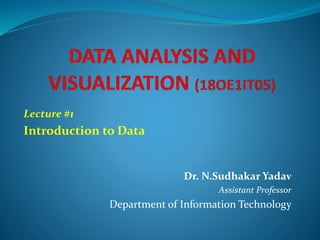
Big data.pptx
- 1. Dr. N.Sudhakar Yadav Assistant Professor Department of Information Technology Lecture #1 Introduction to Data
- 2. In today’s discussion… Introduction to data Current trend Data and Big data Big data vs. small data Tools and techniques 2
- 3. Introduction to data Example: 10, 25, …, Hyderabad, 18IT002, namo@gov.in Anything else? Data vs. Information 100.0, 0.0, 250.0, 150.0, 220.0, 300.0, 110.0 Is there any information? 3
- 4. How large your data is? What is the maximum file size you have dealt so far? Movies/files/streaming video that you have used? What is the maximum download speed you get? To retrieve data stored in distant locations? How fast your computation is? How much time to just transfer from you, process and get result? 4
- 6. Sources of data “Every day, we create 2.5 quintillion bytes of data So much that 90% of the data in the world today has been created in the last two years alone. The data come from several sources sensors used to gather climate information posts to social media sites, digital pictures and videos purchase transaction records cell phone GPS signals etc. …… to name a few! 6
- 7. Examples Social media and networks (All of us are generating data) Scientific instruments (Collecting all sorts of data) Mobile devices (Tracking all objects all the time) Sensor technology and networks (Measuring all kinds of data) 7
- 8. Now data is Big data! No single standard definition! ‘Big-data’ is similar to ‘Small-data’, but bigger …but having data bigger consequently requires different approaches techniques, tools and architectures …to solve: new problems …and, of course, in a better way Big data is data whose scale, diversity, and complexity require new architecture, techniques, algorithms, and analytics to manage it and extract value and hidden knowledge from it… 8
- 9. Characteristics of Big data: V3 9
- 10. V3 : V for Volume Exponential increase in collected/generated data 10 Volume of data, which needs to be processed is increasing rapidly More storage capacity More computation More tools and techniques
- 11. V3: V for Variety Various formats, types, and structures Text, numerical, images, audio, video, sequences, time series, social media data, multi- dimensional arrays, etc… Static data vs. streaming data A single application can be generating/collecting many types of data To extract knowledge all these types of data need to be linked together 11
- 12. V3: V for Velocity Data is being generated fast and need to be processed fast For time-sensitive processes such as catching fraud, big data must be used as it streams into your enterprise in order to maximize its value Scrutinize 5 million trade events created each day to identify potential fraud Analyze 500 million daily call detail records in real-time to predict customer churn faster Sometimes, 2 minutes is too late! The latest we have heard is 10 ns (nano seconds) delay is too much 12
- 13. Big data vs. small data - Optimizations and predictive analytics - Complex statistical analysis - All types of data, and many sources - Very large datasets - More of a real-time - Ad-hoc querying and reporting - Data mining techniques - Structured data, typical sources - Small to mid-size datasets 13
- 14. Big data vs. small data Big data is more real-time in nature than traditional applications Big data architecture Traditional architectures are not well-suited for big data applications (e.g. Exa-data, Tera-data) Massively parallel processing, scale out architectures are well-suited for big data applications 14
- 15. Challenges ahead… The Bottleneck is in technology New architecture, algorithms, techniques are needed Also in technical skills Experts in using the new technology and dealing with Big data Who are the major players in the world of Big data? 15
- 17. Major players… Google Hadoop MapReduce Mahout Apache Hbase Cassandra 17
- 18. Tools available NoSQL DatabasesMongoDB, CouchDB, Cassandra, Redis, BigTable, Hbase, Hypertable, Voldemort, Riak, ZooKeeper MapReduce Hadoop, Hive, Pig, Cascading, Cascalog, mrjob, Caffeine, S4, MapR, Acunu, Flume, Kafka, Azkaban, Oozie, Greenplum Storage S3, HDFS, GDFS Servers EC2, Google App Engine, Elastic, Beanstalk, Heroku Processing R, Yahoo! Pipes, Mechanical Turk, Solr/Lucene, ElasticSearch, Datameer, BigSheets, Tinkerpop 18